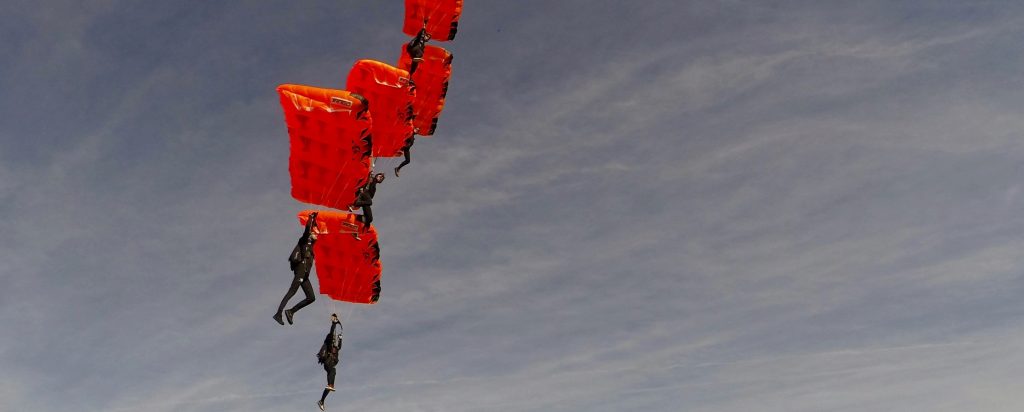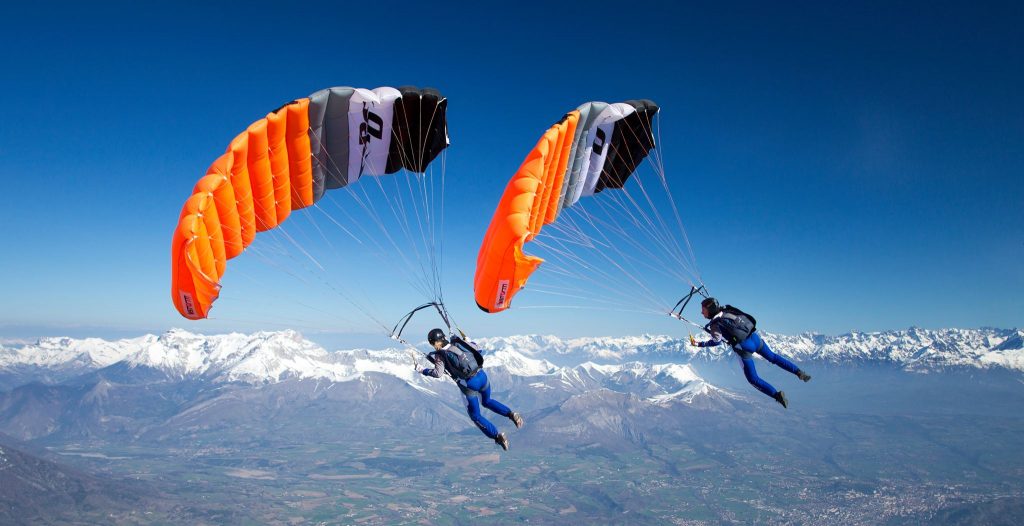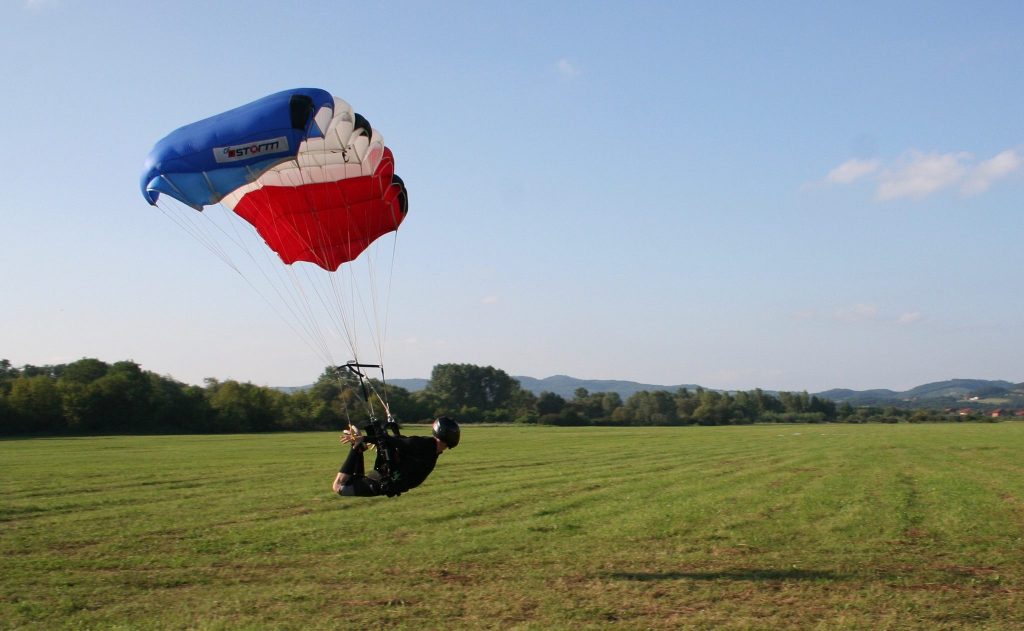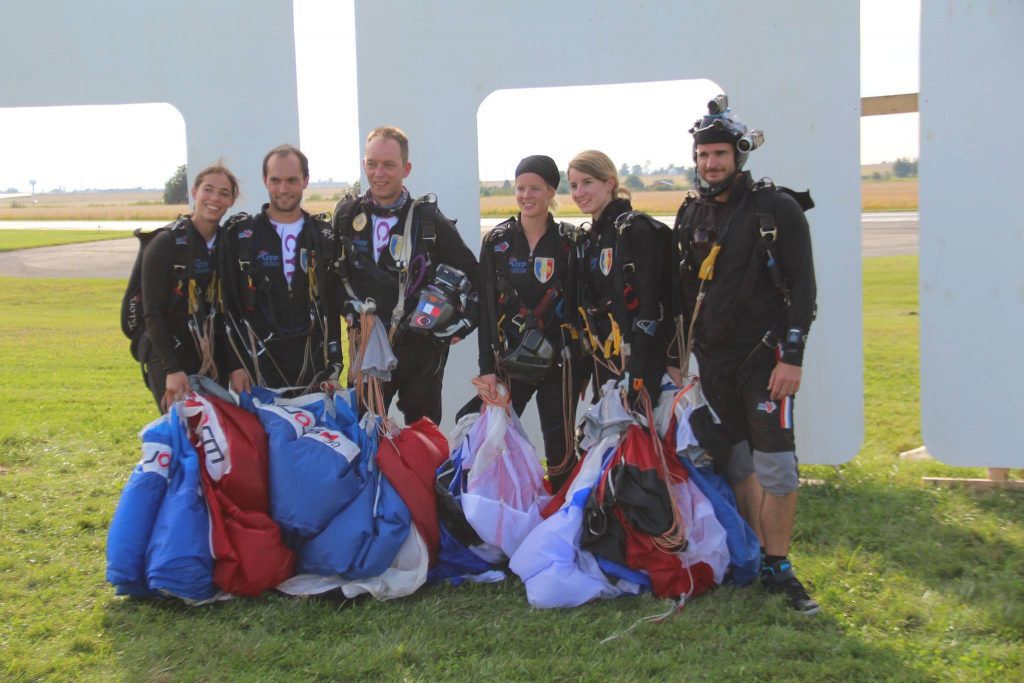Second article of the feedback’s series
5 trainings have been made in France since our return from Eloy : 7 to 15 of April, 28 of April to 6 of May, 21 to 27 of May, 4 to 10 and 18 to 24 of June, with a break for the French Cup of Canopy Formation (1st to 3rd of June).
The « catastrophic » weather of the first training which took place in Gap didn’t allow to reach the ~60 jumps goal planned initially (on 9 days). Only 35 jumps have been made by the two teams, half of which between 1500m and 1200m instead of the 2200~2500m needed to work correctly. Between low ceiling and strong and violent west (and east) winds in altitude and on the ground, the two 2-way teams have been forced almost every day to stop without making their 8~9 daily jumps.
The weather on the second training (Gap) has been more skydive friendly but far from allowing us to make a « comfortable » training. The teams had to ignore the turbulences in altitude to still make their jumps, telling themselves that, if they managed to perform in turbulent conditions, they should be able to perform later in normal conditions.
For the third training which took place this time in Besancon, the thunderstorms decided to invite themselves and did disturb the course of the jumps on multiple times. In the end, the 2 teams totalize 38 jumps on 7 days which was not the initial goal.
After the first French Cup of Canopy Formation which took place in Montbéliard, the 4th training took place in Besancon, but we were forced to move back to Montbéliard because of an unavailability of the plane of Besançon. However, because of a quite nice weather at the beginning in Besançon, and because of very capable pilots in Montbéliard, the 2 teams managed to make a correct training, despite the tiredness of the teammates after the French Cup.
The 5th training, which took place in Saumur, finally allowed the teams to free themselves mentally without focussing on the weather or on the organisation of the manifest, with still a day with zero jumps, but with a very positive result.

Technically, the work has been difficult to put in place.
Several evaluation sequences were planned, aiming to make an assessment of the situation after Eloy and the 110 jumps we made there and to identify which were the particular points needing work. Those sequences were meant to reproduce the same draw as in competition and the 2 teams were meant to realize these jumps in the same conditions. Because of the weather conditions on the 2 first trainings in Gap, the 2 teams were not allowed to realize correctly these sequences and no objective state of the situation was possible.
It’s only after the 4 first days of the training in Besançon that an assessment was possible, showing the movements to improve. Most of the work needs to be on the movements going down, but also on particular points that come often in a draw like the transitions F > D > C for example (transition from the right to the left, then a dive) where the inertia generated but the right > left movement can be penalizing if not dealt with correctly when realizing the dive movement to go to the C dock or B or A.
This allowed us to end the 1st training in Besançon with a come back to the jumps called « analytic » where each transition is repeated a maximum of times with some breaks to get back to a stable and controlled flight.
The last 2 trainings followed the same pattern with 8 evaluation jumps at the beginning of the training followed by some work on specific moves for the end of the week. A focus has been made on the transitions of 3 points minimum where the goal was to make the best transition between each point and to identify what was making them losing time, and which transitions really needed some breaks in the moves to come back in the good move. At the end of these 2 trainings, the 2 teams finished theirs jumps with good feelings and the work really began to pay.
Equipment, equipment, equipment…
While improving their techniques, the teams continue to optimize their equipment, with a particular attention for the canopies, key element in our discipline.
In 2011, all the French Canopy Formation Teams chose to switch to the CF Storm by Performance Designs (the 2-way A team has already been flying Storm 107 since 2009) and in 2018, they total more than 47 000 jumps with these canopies, mainly with 107, 97 and 89. Also in 2016, the 2-way A team started to take part in the development of the XA, named Tango, by making more than 2000 jumps with different prototypes.
Previously, the teams jumped Diamant 160 (and Rubis 140 before) and Triathlon 135 and 120.
A big turn was made after the appearance in 2-way of turning transitions. These techniques required the use of faster canopies to orientate them while remaining on level with respect to his teammate. In 2007/8, the Triathlon allowed to realize these movements, but quickly, the 2-way French teams adopted in 2009 the first Storm 107 to make the most of these techniques.

With this feedback, all the teams did transition to Storms in the early 2011 (Storm 120 for the 4-way Sequential, 107 for 4-way Rotation and 97 for 2-way Sequential), which brought up new issues inherent to the rapid flight of the Storm compared to the canopies used previously. Among other things, the pilot chute placed on the top skin of the canopy was constantly re-inflated because of the speed of the air flow and caused shaking in the flight, and the canopy was « going up » after taking the front risers (!!!), something unknown at the time for those who were flying in Diamant.
The first problem was corrected by adding a « kill-cone » on the retractable bridle (a sort of cotton disc that stifles the pilot chute once the canopy is deployed).
The second “problem” was corrected by changing the flight technics, something not necessarily easy: during the first training in Storm (Eloy in February 2011), the 4-way sequential team was highly reluctant to adopt their Storm 120. After 40 ~ 50 test jumps, the team members almost wanted to go back to Diamant 160 and argued that it would be very complicated to make 4-way sequential correctly with these canopies. Nevertheless, they felt the potential of the canopies in the medium term and it took the 3 weeks of the training to start replacing the old technics.
The arrival of the Storms in Canopy Formation also brought with them some side effects. On the one hand, the openings became healthier and less violent than the Triathlon 135 in particular and on the other hand, the landings became easier compared to the Diamant 160. This allowed to increase the mental availability of the performers for the jumps and indirectly increase performance.

Also, the openings, more « gradual », forced the 4-way teams to change their exit with only the number 1 and 2 out of the plane at the same time, followed by number 3 after the opening of No. 2 and then the No. 4. Indeed, slightly longer openings no longer allowed all 3 performers out at once (this caused too much height between 1 and 3 and collision risks during the opening time). Finally, these « 2-way exit » and more gradual openings no longer required the use of Pull Out and all rigs were equipped with Hand-Deploy pockets.
When the teams started using Storms in 2011, they switched to a product already well developed. Very few changes have been made between the 2011 versions and those used today.
The major improvement was the switch to Vectran instead of the good old Dacron. Until 2011, the CF Storm was delivered with a lineset in Dacron 600, the usual type of lines in canopy formation, because the lines were thick enough not to hurt when docking hardly (and strong enough too).

In 2012, the CF Storm 107 of the 4-way sequential team were delivered with Vectran 750 lines. The team was very skeptical when receiving them, because this type of lines was very thin and despite the fact that the 2-way A team of the time was jumping with Vectran 750, the issue of the docks in 4-way was serious, but not for long. After a day of jumps, there was no question of returning to Dacron. Indeed, the thiner lines required to make cleaner docks, but the benefit in flight on the performance of the canopies was immediate. The thiner Vectran had much less drag than the Dacron and the Storms equipped with Vectran had a higher trajectory speed and therefore a better flight. Another positive effect, but the teams observed that later, was the stability of the trim, the Vectran not moving in terms of dimension over time. Thanks to this, the canopies kept their properties in flight throughout their life.
In 2012, the teams from 4-way Sequential, 4-way Rotation and 2-way Sequential were crowned World Champions, all equipped with CF Storm 107, 97 and 89.
Then, as each team progressed, they gradually downsized. The adoption of smaller Storms allowed for greater responsiveness, faster flight with more loaded canopies, and immediate time savings due to shorter distances between docks due to smaller canopies and linesets (immediate time saving without accelerating techniques or gestures). However, the use of smaller and therefore more nervous canopies is less forgiving regarding the canopy formation part of the flight and each team went down to one size smaller only when their flying level allowed it without ever cutting corners.

At the beginning of 2013, the 2-way B team switched to 97, then at the end of 2013, the 4-way sequential team switched to 97, and at the beginning of 2014 the Rotation switched to 89 and the 2-way A team to 83.
Between each canopy size, each team spent between 400 and 1000 jumps, taking advantage of the maximum potential of each size before allowing themselves to use a more powerful model.
The transition from 107 to 97 for the 4-way sequential team has brought a lot. The new “light” performers’ (~ 82 / 86kg equipped) were almost under-loaded under their 107, which was no longer the case with the 97. The canopies were flying faster on trajectory, were more in pressure, more reactive, with a larger recovery arc, in short, only advantages.
In the same way in Rotation, the switch to 89 brought a lot, the 89 diving more than their 107 and 97 and the teammates of the Rotation being more loaded (90 ~ 95kg equipped).
For the 2-way sequential, the teams gradually descended to the smallest size available in CF Storm at the time in 2014 (83 ft2). At this level, we arrived at the limit of what bi-cellular 7 cells canopies could bring . Depending on the wing load, the performances could even begin to deteriorate if the canopy was too heavily loaded as with the 2-way team Techer / Pourcelot for whom the passage from 89 to 83 did not bring as much as for the team Delay / Collot which were lighter.
The 4-way teams have never downsized on smaller surfaces.
The Rotation team tried during ~ 60 jumps the 83, to finally come back on the 89 and still beat the world record in 2016. During the jumps in 83, few differences were noticeable in the gesture and the technique, but everything was a little easier. After a few jumps of adjustment and adaptation, the canopies were diving better, the rotations were faster and a few tenths of seconds were quickly gained. Only the landings became tricky, because the Rotation is a discipline where the canopies are set with short brake lines, and it significantly degrades the potential of the canopy on the landing (on the contrary, the 2-way in 83 was doing very well because 2-way is practiced with canopies set with full speed, and therefore with all the potential of the canopy for the landing). Following the accident of Benoit Rotty in July 2015, the team went back to their 89 and integrated the alternate, Rodolphe Pourcelot, to participate in the World Air Games in December and still bring the Silver home. The team remained in 89 until the World Championship even after the return of Benoit in the jumps. Realizing 23pts during training (and even a 24), the potential was enough to get the gold in Chicago without having to return to the 83.
For the 4-way sequential, the choice was made to stay in 97 in 2015/16 because there was still potential to exploit on these sizes. Also, the experience of the other teams indicated that the 89 would not have had the same behavior and it would probably have been necessary to adapt certain flight techniques. In the end, the 4-way sequential team of Qatar wins in 2016 with different and more aggressive flight techniques, a total versatility of the 4 teammates, 1000 jumps / year and … Storms 89.

After 2014, the Storm concept comes to the maximum of its capabilities. At this time, a big job was asked to PD to produce a new Canopy Formation canopy, more efficient than the Storm 83, especially as regards the 2-way sequential. The A team of the time composed of Charline Delay and Cindy Collot had exploited almost all the potential of the canopy and there was no way we could let a lower level team pass in front of them thanks to a better equipment. Many ideas have been proposed to PD, ideas coming out of the imaginative minds of Jean-Michel Poulet and Guillaume Dubois: hybrid tri-cell / bi-cell canopies, triangular canopies, canopies in “tail of magpies” …
After a complicated start of the 2015 season – where among others the 2-way A team, wanting to have better equipment than the Storm 83, made ~ 200 jumps with Matrix 2 from NZ Aerosport – PD announced that the development of new prototypes was ongoing without revealing too much and that they would be operational early 2016. In the meantime, they sent us Storms 78 for Charline and Cindy, canopies with which they won the World Air Games at the end of 2015. These 78 were only used to wait until the arrival of the prototypes and only Charline and Cindy jumped with them. They have 150 jumps, are almost new and will probably never be seen again.
At the beginning of 2016, the prototypes arrived under the code name “XA” and in 72ft2 size. Their flight performances and potential are immediately felt. Only the openings are capricious and the landings very technical. The “XA” are 5-cell and tri-cellular canopies (while the Storm is a bi-cellular 7-cell canopy). They will be baptized “Tango” at the 2016 World Championships by PD, referring to the dance step that the performers execute during the ground briefing.

This concept of making high-performance tri-cell 5-cell Canopy Formation canopies was on PD mind for some time. This reduces again the area compared to Storm without reducing performance. Also, the faster and more pressurized canopy is more solid and allows more engaged and direct dives. The work on top is also easier because, among other things, there are only 6 lines on the leading edge against 8 on the Storm and the XA is more nervous.
Regarding the landings, changes in the top part of the steering lines made it less critical and more manageable. The openings have been improved by modifying the slider and moving the position of the half-brake point, which allowed to canalize the lineset during opening and to avoid stall openings.

Thus, the 2-way team Charline / Cindy participated in the 2016 World Championships with these XA72 blue-white-red, crushing the competition with 41 pts ahead of the other french team composed of Alexandra Petitjean and Guillaume Dubois which ranked second (and who were in Storm 83 given their level in 2016).
In 2017, the 2-way Alexandra / Guillaume passed in XA83 then quickly in XA72, the XA83 needing to be returned to PD and the XA78 not being operational yet. The work with PD has thus continued via dense feedback on the behavior of the canopies.

This allowed, among other things, to detect and correct one of the probable reasons which generated the autorotation at the opening, and led to the production of XA78 which have been tested by the 2-way A team at the beginning of 2018 in Eloy, returned to PD for some modification, tested again and validated by the 2-way A team and now used by the 2-way B team.
Today, the work with PD continues on the development of the XA, with as main axis of development the improvement of openings which are still very demanding and requiring rigorously symmetrical packing and an absolutely irreproachable opening position. On the performance side, the potential is there to let the two 2-way teams bring back medals !
Let’s do It !